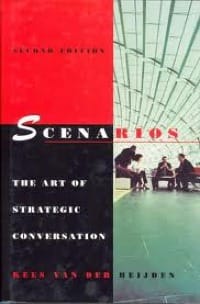New Book Review: "Scenarios"
New book review for Scenarios: The Art of Strategic Conversation (Second Edition), by Kees van der Heijden, Wiley, 2005:


This effort seemed to be among the most respected texts amongst the short list of scenario planning efforts in the current marketplace, but the opinions of other readers with regard to what Heijden has to offer vary quite a bit, so I was not sure what to expect. While this text exclaims that "the entire text has been rewritten to bring it up-to-date and make it more practical whilst retaining the underlying rigor", and reading it in its entirety points in the direction of the author looking to practicality, I do not expect much of what is offered here to be tangible enough for most readers who seek to bring scenario planning into their workplaces. That said, the underlying rigor of this text will probably lend itself well to an academic setting, because the author does go into a fairly high degree of theoretical detail that instructors and students will likely find of value. The information provided is applicable to the workplace, but it will be challenging to apply.
After discussing a number of assumptions on which thinking about strategy is based, the author discusses the theory of scenario thinking, followed by the scenario-based planning process (the bulk of what the author presents, consuming approximately 35% of the text), and the wider institutional behavior context (approximately 23% of the text). In my opinion, these first two areas of discussion are more well done than the latter two. The intial preface and contextual chapters are especially well done. The book starts with an interview of the author by Peter Schwartz, a well known scenario planner, about scenarios and the art of strategic conversation. In some ways, I think that more books should start in this manner, because this formula does introduce the material well, but from another perspective it seems awkward because much of the book is consumed by the nature of scenario planning rather than how to actually apply it, and so the author spends a lot of time refining his thoughts on topics which could consume much less space had editors been involved in the process.
For readers new to the concept of scenario planning, the author explains that "in the final analysis the organization needs a good and unique fit with its ever-changing environment if its aims are to be achieved. The purpose of strategising is to develop policies guiding personal behaviour of individuals in the organization such that the total system achieves and maintains a good and unique fit. The problem is that this has to be achieved in a situation of uncertainty and ambiguity. If everything is known and predetermined there is no place for strategy. But equally, if everything is totally uncertain and nothing is predictable strategy is impossible. The idea of strategising for the future is fundamentally based on the unpredictability of the future, of which some aspects, we assume, can be foreseen…Scenario planning distinguishes itself from other more traditional approaches to strategic planning through its explicit approach towards ambiguity and uncertainty in the strategic question. The most fundamental aspect of introducing uncertainty in the strategic equation is that it turns planning for the future from a once-off episodic design activity into an ongoing learning proposition."
"In a situation of uncertainty, planning becomes learning, which never stops. We have an in-built urge to try to pin down situations, and to try to reach a point where we have got it sorted out in our mind. If uncertainty is acknowledged it is not any longer possible to take this position of 'we have done the planning'. The idea of continuous learning may be less comfortable for some, as it does not give us the feeling of problem closure. However, strategy is about the future, and therefore involves uncertainty. The traditional approach tries to eliminate uncertainty from the strategic equation, by the assumption of the existence of knowledgeable people who have privileged knowledge about 'the most likely future', who can assess the probabilities of specific outcomes. Scenario-based planning, on the other hand, assumes that there is irreducible indeterminacy and ambiguity in any situation faced by the strategist, and that successful strategy can only be developed in an ongoing dynamic response to this."
The author argues that the very nature of strategy in itself is a bit esoteric, and his extensive exploration of the subject is what makes this book appealing, although I find writers of other texts in the strategy space to be much more relatable, such as Henry Mintzberg, Bruce Ahlstrand, and Joseph Lampel in their book "Strategy Safari: A Guided Tour Through the Wilds of Strategic Management" (see my review). In my opinion, one of the best takeaways from what Kees van der Heijden has to offer here, even if the reader does not make their way through the entire text, is as follows: "Strategy is a highly dynamic area, full of fads and fashions that come and go. Yet a few texts seem to remain valid over the years. These mostly aim at analysing underlying structures rather than proposing specific strategies. After all, copying ideas that 'work' for others is unlikely to be a winning strategy. Success can only be based on being different from (existing or potential) competitors." Well said.